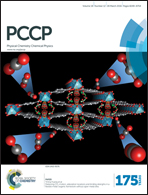Triangular lattice exciton model†
Abstract
We present a minimalistic equilateral triangular lattice model showing explicitly that the two-dimensional hydrogen model for excitons breaks down for excitons in semiconducting monolayer transition-metal dichalcogenides due to lattice effects and that these excitons are neither Wannier nor Frenkel excitons but rather span an intermediate regime. The model is formulated on sparse form in direct space, allowing it to be solved with great computational efficiency.


 Please wait while we load your content...
Please wait while we load your content...